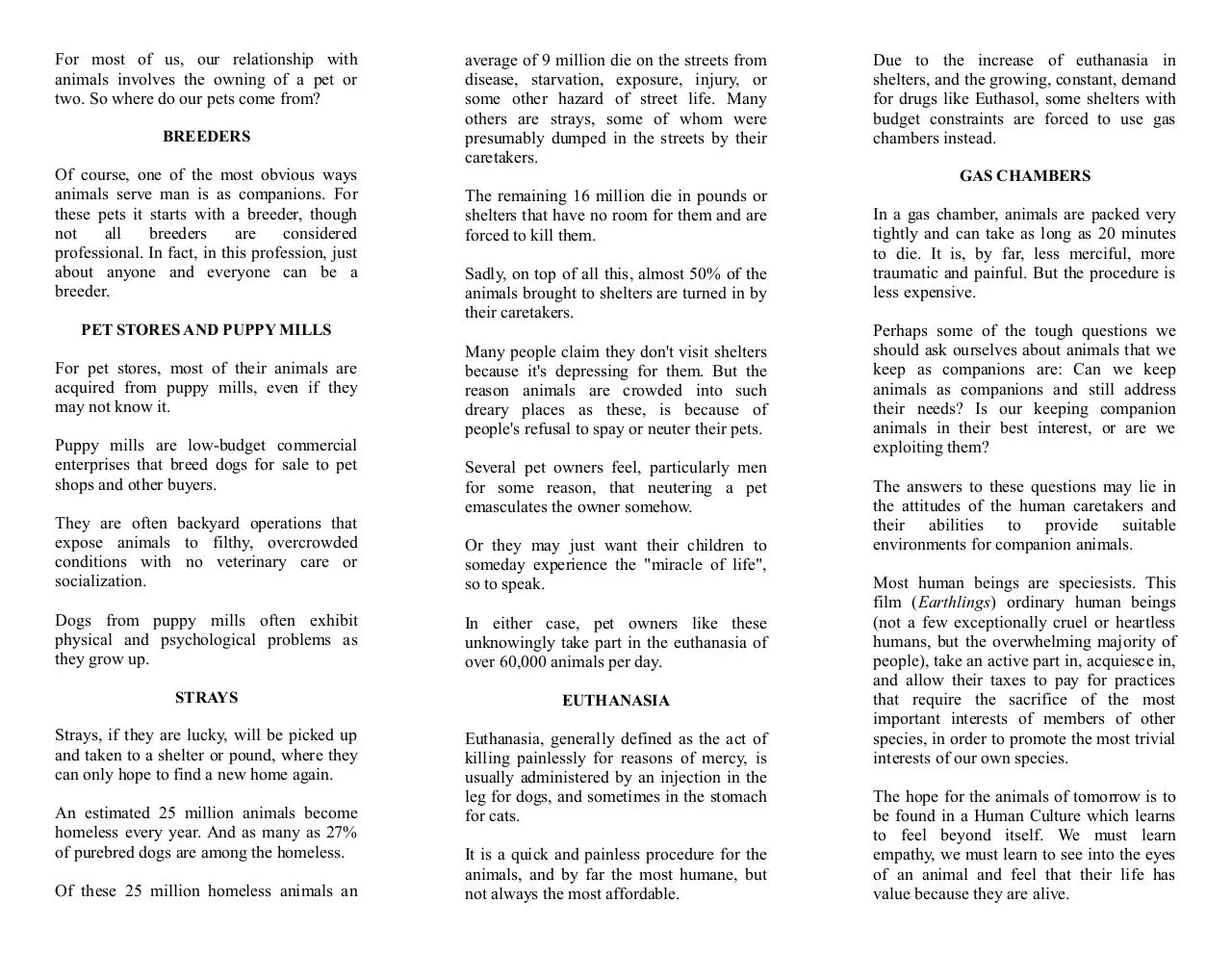english (PDF)
File information
Title: Three Panel Brochure
This PDF 1.4 document has been generated by Draw / LibreOffice 3.3, and has been sent on pdf-archive.com on 17/06/2017 at 11:44, from IP address 24.53.x.x.
The current document download page has been viewed 274 times.
File size: 992.77 KB (2 pages).
Privacy: public file


File preview
Empathy
Animals labelled
as Pets
Intuitive faculty to understand or feel what another
feels, to place oneself in the position of others.
Catherine Boutin
Text on the verso from the documentary
Earthlings (2005) part 1, Pets
Sofia Hadjis
To watch the entire documentary Earthlings
https://www.nationearth.com/earthlings-1/
Animals and speciesism (in french)
https://youtu.be/Sed0LXyJp-A
Dangers outside for cats
https://youtu.be/5nlIEdLL8ik
Jaelle Béliveau
Lost/found cat or dog?
http://www.petluck.ca/en/
More information on facebook
Animaux Avec Nous / Animals With Us
Can we keep animals as
companions and still
address their needs?
Le Journal de Montréal
July 20 2015
Animaux Avec Nous
Daniel Richard
Tessie Racanelli
Is our keeping
companion animals in
their best interest, or are
we exploiting them?
For most of us, our relationship with
animals involves the owning of a pet or
two. So where do our pets come from?
BREEDERS
Of course, one of the most obvious ways
animals serve man is as companions. For
these pets it starts with a breeder, though
not
all
breeders
are
considered
professional. In fact, in this profession, just
about anyone and everyone can be a
breeder.
PET STORES AND PUPPY MILLS
For pet stores, most of their animals are
acquired from puppy mills, even if they
may not know it.
Puppy mills are low-budget commercial
enterprises that breed dogs for sale to pet
shops and other buyers.
They are often backyard operations that
expose animals to filthy, overcrowded
conditions with no veterinary care or
socialization.
average of 9 million die on the streets from
disease, starvation, exposure, injury, or
some other hazard of street life. Many
others are strays, some of whom were
presumably dumped in the streets by their
caretakers.
GAS CHAMBERS
The remaining 16 million die in pounds or
shelters that have no room for them and are
forced to kill them.
Sadly, on top of all this, almost 50% of the
animals brought to shelters are turned in by
their caretakers.
Many people claim they don't visit shelters
because it's depressing for them. But the
reason animals are crowded into such
dreary places as these, is because of
people's refusal to spay or neuter their pets.
Several pet owners feel, particularly men
for some reason, that neutering a pet
emasculates the owner somehow.
Or they may just want their children to
someday experience the "miracle of life",
so to speak.
Dogs from puppy mills often exhibit
physical and psychological problems as
they grow up.
In either case, pet owners like these
unknowingly take part in the euthanasia of
over 60,000 animals per day.
STRAYS
EUTHANASIA
Strays, if they are lucky, will be picked up
and taken to a shelter or pound, where they
can only hope to find a new home again.
Euthanasia, generally defined as the act of
killing painlessly for reasons of mercy, is
usually administered by an injection in the
leg for dogs, and sometimes in the stomach
for cats.
An estimated 25 million animals become
homeless every year. And as many as 27%
of purebred dogs are among the homeless.
Of these 25 million homeless animals an
animals
Due to the increase of euthanasia in
shelters, and the growing, constant, demand
for drugs like Euthasol, some shelters with
budget constraints are forced to use gas
chambers instead.
It is a quick and painless procedure for the
animals, and by far the most humane, but
not always the most affordable.
In a gas chamber, animals are packed very
tightly and can take as long as 20 minutes
to die. It is, by far, less merciful, more
traumatic and painful. But the procedure is
less expensive.
Perhaps some of the tough questions we
should ask ourselves about animals that we
keep as companions are: Can we keep
animals as companions and still address
their needs? Is our keeping companion
animals in their best interest, or are we
exploiting them?
The answers to these questions may lie in
the attitudes of the human caretakers and
their abilities to provide suitable
environments for companion animals.
Most human beings are speciesists. This
film (Earthlings) ordinary human beings
(not a few exceptionally cruel or heartless
humans, but the overwhelming majority of
people), take an active part in, acquiesce in,
and allow their taxes to pay for practices
that require the sacrifice of the most
important interests of members of other
species, in order to promote the most trivial
interests of our own species.
The hope for the animals of tomorrow is to
be found in a Human Culture which learns
to feel beyond itself. We must learn
empathy, we must learn to see into the eyes
of an animal and feel that their life has
value because they are alive.
Download english
english.pdf (PDF, 992.77 KB)
Download PDF
Share this file on social networks
Link to this page
Permanent link
Use the permanent link to the download page to share your document on Facebook, Twitter, LinkedIn, or directly with a contact by e-Mail, Messenger, Whatsapp, Line..
Short link
Use the short link to share your document on Twitter or by text message (SMS)
HTML Code
Copy the following HTML code to share your document on a Website or Blog
QR Code to this page

This file has been shared publicly by a user of PDF Archive.
Document ID: 0000613527.